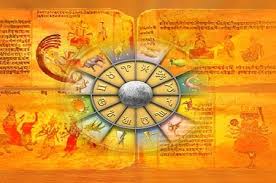1. Samhita (Mundane Astrology):
This branch focuses on predicting large-scale events, including natural phenomena and societal trends. It’s often used to study weather patterns, earthquakes, and even the rise and fall of empires.
- Example: Based on Samhita, astrologers might predict heavy rainfall during the monsoon season by analyzing planetary alignments and their historical correlations with weather patterns. Similarly, an alignment involving Saturn and Mars could be associated with potential geopolitical unrest.
2. Siddhanta (Astronomy and Mathematical Astrology):
This branch forms the technical foundation of astrology, dealing with precise astronomical calculations, such as the motion of planets and the creation of Panchangas (Vedic almanacs).
- Example: If you want to create a birth chart, Siddhanta is used to calculate the exact planetary positions at the time of your birth. For instance, the angular distance between the Sun and Moon determines the phase of the moon on that day, influencing astrological interpretations.
3. Hora (Predictive Astrology):
Hora is the most personal and widely used branch, focusing on individual predictions. It examines an individual’s life through their birth chart (Janma Kundali).
- Sub-branches:
- Jataka: Looks at long-term life patterns based on birth charts.
- Gochara (Transits): Observes planetary movements and their short-term effects.
- Dasha: Examines planetary periods that influence phases of life.
- Example: Suppose an individual is running through the “Shani Dasha” (Saturn’s period). Hora astrology might indicate this period as one of discipline, hard work, and possible challenges, depending on Saturn’s position in their chart.
4. Prashna (Horary Astrology):
Prashna addresses specific questions, using the planetary positions at the exact moment the question is asked. This is particularly useful for immediate concerns or dilemmas.
- Example: If someone wants to know whether they should invest in a particular business, the astrologer would cast a chart for the time the question was posed. If Jupiter (the planet of growth) is favorably placed, it could indicate a good outcome.
5. Shakuna (Omens and Intuition):
Shakuna focuses on interpreting signs and omens observed in daily life. It combines intuition with astrology to offer guidance.
- Example: If a person encounters an eagle while setting out on a journey, Shakuna astrology might interpret this as an auspicious sign of success and accomplishment, provided the overall cosmic energies align.
6. Other Specialized Branches:
In addition to the above, there are other branches like:
- Nadi Astrology: Deals with detailed readings based on ancient scripts.
- Medical Astrology: Focuses on health and well-being based on planetary influences.
- Electional Astrology (Muhurta): Determines the best timings for important events like weddings, travel, or business launches.
- Example: For a marriage ceremony, electional astrology might suggest a date and time when Venus (symbolizing love) and Jupiter (symbolizing blessings) are favorably positioned.




